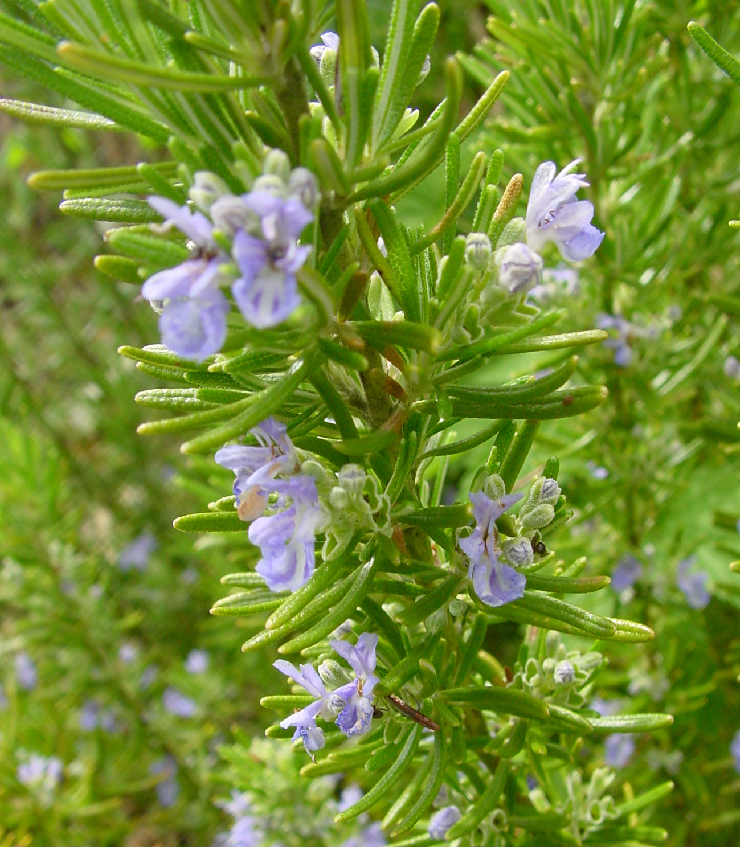Rosmarinus Officinalis
Rosemary
The purple-blue flowers of Rosmarinus Officinalis are borne on upright spikes from mid-spring to early summer. It has heavily aromatic dark green leaves, perfect for a sunny border or herb garden, and the young leaves are great for flavouring roasted vegetables, lamb and pork dishes. An absolute must in any herb garden for its aroma, attractive leaves and flowers. It makes a great fragrant low growing evergreen screen, and whilst the eventual height is up to 5ft, it is easy to maintain as a small compact bush or low hedge.
Growing rosemary in your garden can be a rewarding experience. This hardy and drought-tolerant shrub thrives in well-drained, sandy soil and requires full sun to flourish. Rosemary is well-suited to container gardening and can also be pruned and shaped into attractive topiaries or hedges.
Pruning is essential to keep the plant healthy and encourage bushy growth. Regularly trimming the tips of the branches not only promotes a more compact shape but also provides an abundance of fresh rosemary for culinary and aromatic uses.
The garden plant Rosmarinus officinalis, commonly known as rosemary, is a beloved herb cherished for its aromatic foliage, culinary versatility, and rich history. This evergreen shrub, native to the Mediterranean region, has found its way into gardens and kitchens worldwide, where it serves as both a culinary delight and a symbol of enduring love and remembrance.
Rosmarinus officinalis belongs to the Lamiaceae family and is characterized by its needle-like leaves, which are green on top and silver-gray on the underside. The plant can reach heights of up to six feet, forming an attractive, upright bush. It produces small, pale blue to white flowers that are both visually appealing and fragrant.
One of rosemary’s most famous attributes is its culinary versatility. Its robust, piney aroma and earthy flavor make it a staple in kitchens worldwide. Rosemary pairs well with a variety of dishes, enhancing the flavor of meats, vegetables, and even bread. In Mediterranean cuisine, rosemary is a key ingredient in traditional dishes like roast lamb and potato dishes. The herb’s resinous needles infuse a delightful aroma and a savory taste into these preparations. When minced finely or used as sprigs, rosemary can elevate roasted vegetables, poultry, and fish, providing a subtle yet distinctive flavor profile. Rosemary also finds its way into bread and pastry recipes, where its fragrance adds depth and character to otherwise ordinary baked goods. Homemade rosemary focaccia or artisanal bread sprinkled with rosemary flakes is a culinary delight.
Rosemary has a long history of medicinal and therapeutic uses. It has been employed for centuries in various cultures to treat a range of ailments. The aromatic oil derived from rosemary contains compounds like rosmarinic acid and essential oils that possess antioxidant, anti-inflammatory, and antimicrobial properties. In traditional medicine, rosemary has been used to alleviate digestive issues, improve memory and concentration, and relieve headaches. Some studies have suggested that rosemary may also have potential benefits for hair growth and skin health. The essential oil extracted from rosemary is utilized in aromatherapy for its invigorating and stimulating properties. Inhaling rosemary oil is believed to boost mood, reduce stress, and enhance cognitive function. It is often used in massage oils and diffusers to promote relaxation and mental clarity.
Rosemary holds a special place in the realm of symbolism and cultural significance. In many cultures, it is associated with memory, fidelity, and remembrance. Ancient Greeks and Romans believed that rosemary improved memory and concentration, and they would wear rosemary wreaths during exams and important events. In the language of flowers, rosemary symbolizes remembrance and loyalty. It is often used in wedding bouquets and boutonnieres to signify enduring love and fidelity. Shakespeare’s famous line in “Hamlet,” where Ophelia says, “There’s rosemary, that’s for remembrance,” further underscores the herb’s connection to memory and love.
Rosmarinus officinalis, or rosemary, is a garden plant cherished for its culinary contributions, medicinal properties, cultural significance, and aromatic allure. Whether it’s gracing a Mediterranean-inspired dish, enhancing your well-being through aromatherapy, or symbolizing love and remembrance in a wedding bouquet, rosemary is a versatile and enduring herb that continues to captivate gardeners, chefs, and cultural enthusiasts alike. Cultivating this fragrant and flavorful herb in your garden ensures a steady supply of culinary delights and a living connection to the rich tapestry of its historical and cultural heritage.







Reviews
There are no reviews yet.